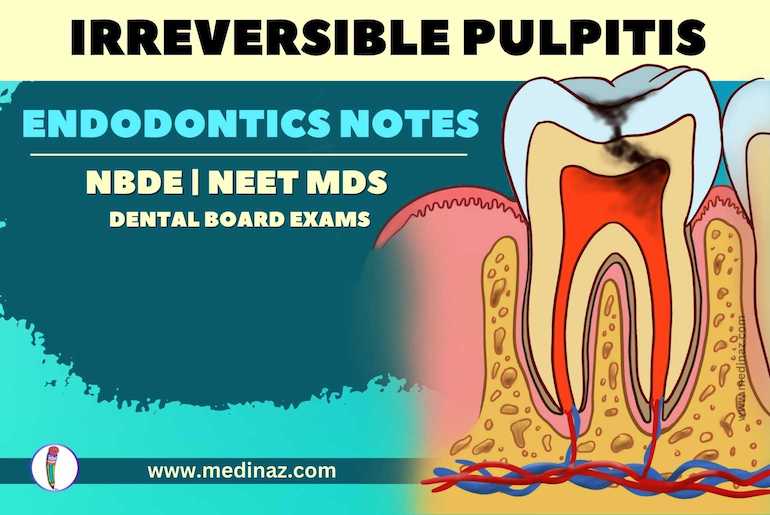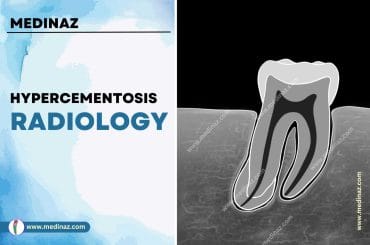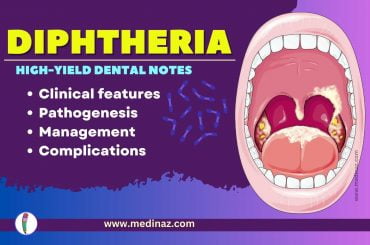Definition of Irreversible Pulpitis:
“It is a persistent inflammatory condition of the pulp, symptomatic or asymptomatic, caused by a noxiousstimulus”. It has both acute and chronic stages in pulp.
Characteristics of Pulpal Pain:
- Rapid onset of pain triggered by sudden temperature changes, sweet or acidic foods.
- Pain persists even after the removal of the stimulus.
- Spontaneous pain can occur and is described as sharp, piercing, intermittent, or continuous.
- Pain worsens when bending down or lying down due to changes in intrapulpal pressure.
- Referred pain may be present, indicating pain felt in other areas associated with the affected tooth.
- In later stages, pain becomes severe, boring, throbbing, and intensifies with hot stimuli.
- Severe pain may keep the patient awake at night.
- Relief of pain can be achieved by using cold water, and patients may come to the dental office with a jar of ice water.
Etiology of Irreversible Pulpitis:
- Pulpitis, commonly caused by bacterial invasion through dental caries.
- Pulpal inflammation can be triggered by chemical, thermal, or mechanical injuries to the pulp.
- If left untreated, reversible pulpitis can progress and develop into irreversible pulpitis.
Diagnosis of Irreversible Pulpitis:
Visual examination and history:
- Previous symptoms may be evident upon examination of the affected tooth.
- Deep cavity involving the pulp or secondary caries under restorations may be observed.
Radiographic findings:
- X-rays can reveal the depth and extent of caries.
- In advanced stages of pulpitis, there may be a slight widening in the periapical area.
Percussion:
The tooth may be tender when tapped (percussed) due to increased intrapulpal pressure caused by inflammatory tissue.
Vitality tests:
Thermal test:
- Hyperalgesic pulp (inflamed pulp) is more sensitive to cold stimulation compared to a normal tooth.
- Pain may persist even after the removal of the irritant.
- As pulpal inflammation progresses, the response intensifies with heat and relieves with cold due to their effects on blood vessels.
Electric test:
- In the initial stages, less current is required to generate a response.
- As the pulp tissue becomes more necrotic, a higher current is needed to elicit a response.

Treatment:
- Pulpectomy, i.e. root canal treatment
Also know:
Symptomatic Irreversible Pulpitis:
- It is a clinical diagnosis indicating that the inflamed pulp is unable to heal.
- Teeth with symptomatic irreversible pulpitis exhibit intermittent or spontaneous pain.
- Heightened and prolonged episodes of pain can be triggered by rapid exposure to dramatic temperature changes, especially cold stimuli.
- Minimal or no changes may be observed in the radiographic appearance of the surrounding bone.
- Advanced irreversible pulpitis may show thickening of the periodontal ligament and evidence of pulpal irritation such as calcification in the pulp chamber or root canal space.
- Deep restorations, caries, pulp exposure, or other insults to the pulp may be present.
- If left untreated, symptomatic irreversible pulpitis can progress to pulp necrosis.
Asymptomatic Irreversible Pulpitis:
- It is a clinical diagnosis indicating that the inflamed pulp is unable to heal.
- Despite the inflammation, the patient does not experience any symptoms.
- Deep caries may not produce symptoms even if it extends into the pulp.
- Without treatment, the tooth may eventually become symptomatic or the pulp may necrose.
- Endodontic treatment should be performed promptly in cases of asymptomatic irreversible pulpitis to prevent the development of symptoms or pulp necrosis that could cause severe pain and distress to the patient.
Check other Free Dental Notes
Reference:
- Cohen’s Pathways of the Pulp; 11th Edition; by Louis H. Berman DDS FACD (Author), Kenneth M. Hargreaves
- Grossman’s Endodontic Practice; 14th Edition
A Visual Learning Platform





